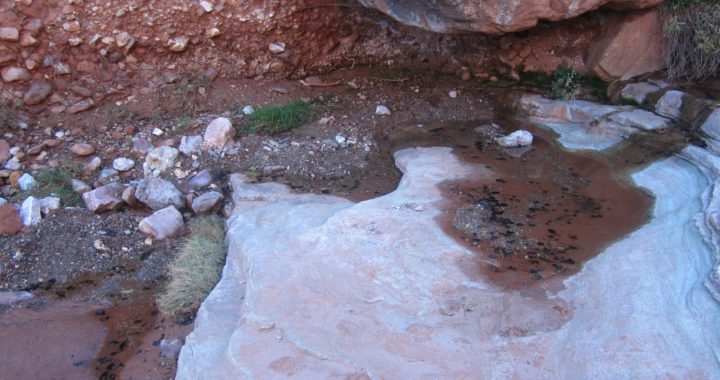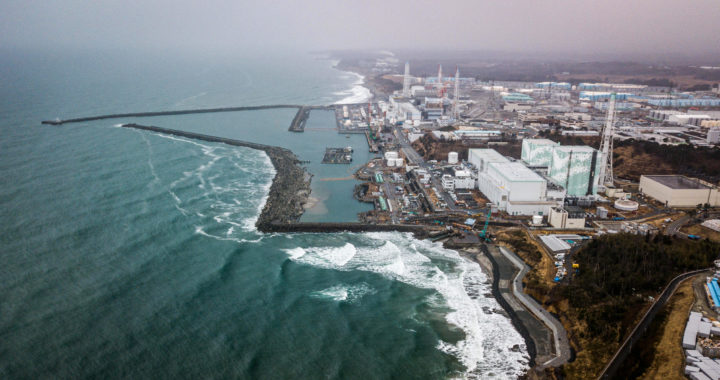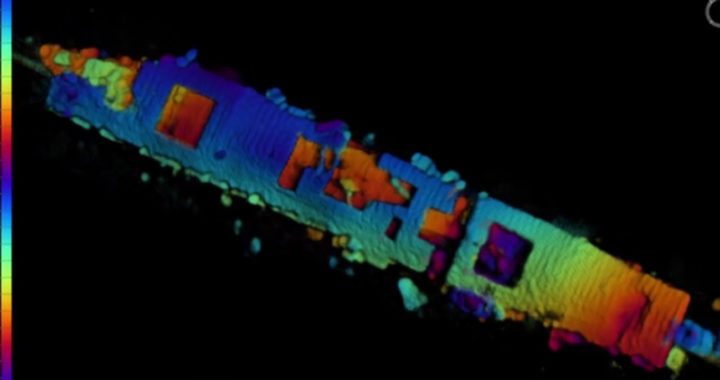Main Figure (above): shows Horn Creek, inside the Grand Canyon, where the samples presented here were collected.
Article Author: Dr. Brian Plimley.
Hikers in the Grand Canyon carry plenty of water because water sources are few and far between along the inner shelf of the canyon. But one stream, Horn Creek, is marked on maps, “Do Not Drink”. It turns out that the stream is considered unsafe because of an old uranium mine, the Orphan Mine, at the canyon rim above it, which leaches uranium decay products into the stream.
RadWatch postdoc Brian Plimley (Figure 1) was backpacking in the area in November 2016 (on his honeymoon) and collected samples of water and sediment from a barely-trickling Horn Creek (Main Figure). The samples were recently measured by Al Smith at the LBL Low-Background Facility, which is even more sensitive to traces of radiation than the RadWatch lab.
|
Figure 1: RadWatch postdoc, Dr. Brian Plimley, along the southern rim of the Grand Canyon.
|
Figure 2: A view from within the canyon, near Horn Creek.
|
Table of Results:
| Sample | U chain (early) | U chain (late) | Th | K |
|---|---|---|---|---|
| Grand Canyon Horn Creek sediment (sand-sized) | 1.6 +- 0.1 ppm | 2.78 +- 0.03 ppm | 6.0 +- 0.1 ppm | 1.01 +- 0.01 % |
| Grand Canyon Horn Creek water | 23 +- 5 ppb | <1 ppb | <2 ppb | 7 +- 1 ppm |
Uranium decay products are divided into two categories, “early” and “late”, split by the presence of radon partway down the decay chain (see Figure 4). Since radon is a gas, it often escapes into the air, and so the decay products before radon are often out of equilibrium with the decay products after radon. In the case of this Horn Creek sediment, the late-chain products are higher in concentration than the early-chain products, which is unusual. It may be caused by a chemical interaction in the uranium ore and the stream.
Figure 4: The uranium decay, showing Radon in the center (author: Tosaka, CC BY 3.0). U chain (early) corresponds to sources up the chain from Radon while U (late) corresponds to those occurring after Radon in the chain.
Are these levels concerning?
Clearly, this sand and water contain uranium. To establish if the levels found are indeed cause for concern, we need to compare these concentrations to what is normal.
Uranium is normally present in soil at small concentrations. The global average is estimated to be between 2 and 4 ppm [1]. Furthermore, LBL Low-Background Facility’s Al Smith has measured soils in the Berkeley area to have around 1-2 ppm, and 2-3 ppm in sandstone. So it appears that the uranium levels in this sediment are not unusual at all. Thorium is normally present in soils at around 6 ppm [2], so the thorium level is also normal.
What about the sample of drinking water? First, please note that the U and Th concentrations in the water sample are measured in ppb (parts per billion) instead of ppm. The EPA regulatory limit for drinking water is 30 µg/L [3], or 30 ppb, so in terms of uranium content in this sample, you could drink this water for your entire life!
The concern about Horn Creek stems from samples that are above the EPA limit for drinking water. USGS has measured levels ranging from 18.9 µg/L to 67.8 µg/L, with other samples in the Orphan Mine vicinity as high as 202 µg/L [4]. These concentrations would be a concern if a person was drinking this water over a long period of time (months or years). In the short term, consuming water at any of these levels for 1-2 days would not be a significant risk.
The uranium concentration will vary with seasons, rainfall, and other effects, so the measurements USGS and RadWatch have made are not necessarily representative of the uranium concentration in Horn Creek at an arbitrary time in the future. Nonetheless, dehydration is a much bigger health risk in the Grand Canyon than uranium in creek water!




